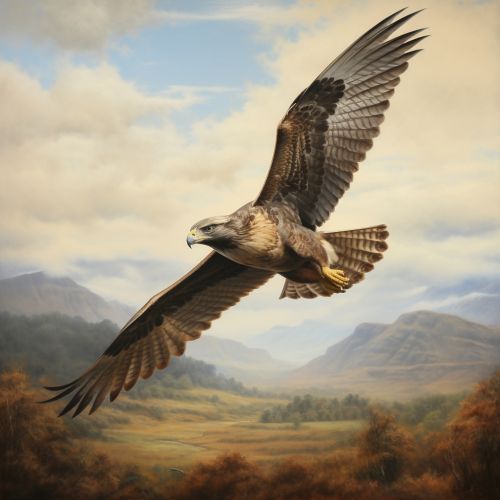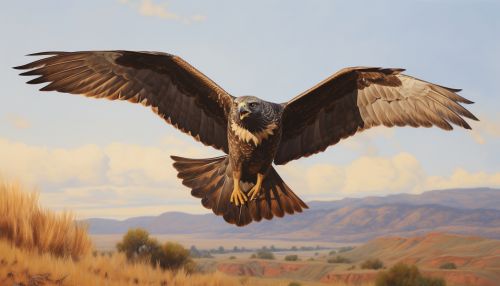Swainson's Hawk
Description
Swainson's Hawk (Buteo swainsoni) is a large bird of prey belonging to the Accipitridae family. It is named after the British naturalist William Swainson. The species is known for its long-distance migratory habits, with some individuals traveling over 20,000 km from breeding grounds in North America to wintering areas in South America.


Taxonomy and Systematics
The Swainson's Hawk is a member of the Buteo genus, a group of medium to large raptors with robust bodies and broad wings. The species was first described by Charles Lucien Bonaparte in 1838. It is monotypic, meaning there are no recognized subspecies.
Morphology
Swainson's Hawks are sexually dimorphic, with females being slightly larger than males. Adult birds typically measure 43 to 56 cm in length, with a wingspan ranging from 117 to 137 cm. The species exhibits two color morphs: a light morph and a dark morph. The light morph is more common and is characterized by a white underbody and a dark brown upper body. The dark morph, on the other hand, is almost entirely dark brown or black.
Distribution and Habitat
Swainson's Hawks are native to North America, where they breed in the western and central regions of the continent. Their breeding range extends from Alaska and Canada down to northern Mexico. During the non-breeding season, they migrate to South America, particularly Argentina, making one of the longest migrations of any raptor.
The species inhabits a variety of open and semi-open habitats, including grasslands, agricultural fields, and prairies. They are often found near water sources and prefer areas with scattered trees for nesting.
Behavior
Swainson's Hawks are diurnal, meaning they are active during the day. They are known for their soaring flight, which they use to search for prey. The species is primarily a solitary hunter, but it may also hunt in groups during migration.
Diet
Swainson's Hawks have a varied diet that changes with the seasons. During the breeding season, they primarily feed on small mammals such as rodents and lagomorphs. In contrast, during migration and winter, they switch to a diet of insects, particularly locusts and grasshoppers.
Reproduction
Swainson's Hawks are monogamous and form long-term pair bonds. The breeding season begins in late April or early May, with the female laying 2 to 3 eggs. Both parents share in incubation duties, which last for about a month. The chicks fledge after around 40 days and remain dependent on their parents for several more weeks.
Conservation Status
The IUCN currently lists Swainson's Hawk as a species of Least Concern. However, the species has faced threats from habitat loss and pesticide exposure. Conservation efforts are ongoing to protect this remarkable migratory raptor.
